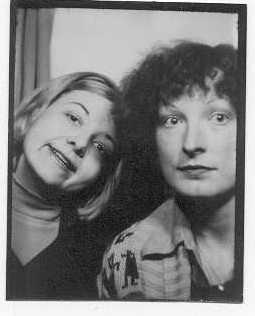Maybe a year ago I saw Supreme Court Justice Antonin Scalia profiled on 60 Minutes. Leslie Stahl was questioning him on Originalism and I thought the whole concept was curious but I was more curious about other aspects of his being.
Recently I saw a repeat of the segment and I found myself thinking a lot about the concept which seems, on some levels, to be peculiar (this is my most benign response) and fairly surreal on others.
I came across this info on the topic on Legal Theory Lexicon "All the concepts that fit."
If you already have an opinion, please share it. If not, please read...digest...respond. In other words, discuss.
Introduction: There are many different theories of constitutional interpretation, but the most controversial and also perhaps the most influential is "originalism"--actually a loosely-knit family of constitutional theories. The idea that courts would look to evidence from the constitutional convention, the ratification debates, The Federalist Papers, and the historical practice shortly after ratification of the Constitution of 1789 (or to equivalent sources for amendments) is an old one. This post provides a very brief introduction to "originalism" that is aimed at law students (especially first-year law students) with an interest in legal theory.
Originalism is not just an ivory tower theory. It has had a profound influence on the practice of constitutional interpretation and the political contest over the shape of the federal judiciary. President Reagan's nomination of Robert Bork (an avowed originalist) was one key moment--with his defeat by the democrats seen as a political rejection of originalism. The current Supreme Court has at least two members who seem strongly influenced by originalist constitutional theory--Associate Justices Antonin Scalia and Clarence Thomas and two others, John Roberts and Samuel Alito who may also be receptive to originalist arguments. In the late 1980s Justice Antonin Scalia suggested that originalists should shift their attention from "the original intentions of the framers" to the "original public meaning of the constitutional text."
The New Originalism The final chapter of the originalism debate in legal theory has yet to be written--and perhaps it never will be. But one last set of developments is particularly important. In the 70s and early 80s, originalism was strongly associated with conservative judicial politics and conservative legal scholars. But in the late 1980s and in the 1990s, this began to change. One of the important moves was the shift from "original intentions" to "original public meaning," but two developments were key. First, Bruce Ackerman's work on constitutional history suggested the availability of "left originalism" that maintained the commitment to the constitutional will of "We the People" but argued that the constitution included a New Deal constitutional moment that legitimated the legacy of the Warren Court. (Ackerman does not call himself an "originalist," but many of Ackerman's former students do work that is implicitly or explicitly originalist.) Second, Randy Barnett (the leading figure in libertarian legal theory) embraced originalism in an influential article entitled An Originalism for Nonoriginalists. The most recent development in this dynamic is Jack Balkin's attempt to reconcile originalism with living constitutionalism.
The original-meaning version of originalism emphasizes the meaning that the Constitution (or its amendments) would have had to the relevant audience at the time of its adoptions. How would the Constitution of 1789 have been understood by an ordinary adult citizen at the time it was adopted? Of course, the same sources that are relevant to original intent are relevant to original meaning. So, for example, the debates at the Constitutional Convention in Philadelphia may shed light on the question how the Constitution produced by the Convention would have been understood by those who did not participate in the secret deliberations of the drafters. But for original-meaning originalists, other sources become of paramount importance. The ratification debates and Federalist Papers can be supplemented by evidence of ordinary usage and by the constructions placed on the Constitution by the political branches and the states in the early years after its adoption. The turn to original meaning made originalism a stronger theory and vitiated many of the powerful objections that had been made against original-intentions originalism.
This sets the stage for what is sometimes called “the New Originalism” and also is called “Original Meaning Originalism.” Whatever the actual origins of this theory, the conventional story identifies Antonin Scalia as having a key role. As early as 1986, Scalia gave a speech exhorting originalists to “change the label from the Doctrine of Original Intent to the Doctrine of Original Meaning.” The phrase “original public meaning” seems to have entered into the contemporary theoretical debates in the work of Gary Lawson with Steven Calabresi as another “early adopter.” The core idea of the revised theory is that the original meaning of the constitution is the original public meaning of the constitutional text.
We are already beginning to see originalists coming to grips with the relationship between original meaning and precedent--both in the narrow sense of Supreme Court decisions and the broader sense of the settled practices of the political branches of government and the states. Some originalists have argued that as a general rule, constitutional actors should give follow original meaning, even if it would conflict with longstanding historical practice or settled precedent. Other originalists argue that precedent and/or historical practice can trump original meaning in specified circumstances.
skip to main |
skip to sidebar







Maybe 1978? Soon after alien abduction.
A blog that prefers to avoid categorization.
United States Aid To Israel 2


FRIENDS: check out their services & products
I SMELL CAKE (bunting)
Scroll down to view EXCELLENT video of the patent leather frosted birthday cake my Mom made for my Brother Mark. I made it with my phone.
My Shutterfly Pix Albums
Brian Eno and friends, blog viewing music
LINKS TO FIRE UP YOUR SENSES
- Flobots
- The Nation (cruise)
- Pitch Nehst
- Free Rice
- Shirley MacLaine's Chakra Jewelry
- Global Incident Map
- Tom's Shoes
- The Coup
- Southern Poverty Law Center
- db clay
- Psycholinguistics
- Dr. Andrew Weil
- Help Palestine
- Northern Sun shopping
- Commercial Free Childhood
- Delancey St. Foundation
- Puppies Behind Bars
- Greyston Bakery TREATS
- Tricycle ~ Buddhist resources
- Trees!
- Brain Exercises
- Ecopsychology
- Carbon Footprint Calculator
- The Mysteries of Kabul
- Legends of the Chelsea Hotel blog
- Buy Nothing for Christmas
- Jobs at Patagonia
Welcome to all Freaks!
Now instead of talking to myself and writing in my journals, I'm going to spill everything into my blog and see if I find the whole thing amusing. If so, I might continue for awhile though sustainability is not my strong suit.
May you find something of remote interest to make your visit worthwhile.
I should point out that I live in Cranston, Rhode Island. If you are clueless about the significance you will be delighted to know that Quahog, the thriving metropolis that is the setting for Family Guy, is based on this perverse place.
And speaking of Quahog, see my friend Peter Armitage's pix below.
May you find something of remote interest to make your visit worthwhile.
I should point out that I live in Cranston, Rhode Island. If you are clueless about the significance you will be delighted to know that Quahog, the thriving metropolis that is the setting for Family Guy, is based on this perverse place.
And speaking of Quahog, see my friend Peter Armitage's pix below.
Peter's Perfect Pix

FABULOUS FILMS
- The Lives of Others
- Anything by the Quay Brothers
- Stalker- Tarkovsky
- The Insider
- The Blair Witch Project
- No Country For Old Men
- 3 Women
- Rushmore
- Until The End of The World
- Pulp Fiction
- The Shining
- Don't Look Now
- Fargo
- Silence of the Lambs
- The Wizard of Oz
- The Fast & The Furious
- Movies
Followers
Blog Archive
-
►
2010
(2)
- ► 01/24 - 01/31 (1)
- ► 01/10 - 01/17 (1)
-
►
2009
(17)
- ► 12/06 - 12/13 (1)
- ► 11/29 - 12/06 (1)
- ► 11/22 - 11/29 (1)
- ► 11/08 - 11/15 (1)
- ► 10/18 - 10/25 (1)
- ► 10/04 - 10/11 (1)
- ► 09/27 - 10/04 (1)
- ► 09/13 - 09/20 (2)
- ► 04/19 - 04/26 (1)
- ► 03/22 - 03/29 (1)
- ► 03/08 - 03/15 (2)
- ► 02/15 - 02/22 (1)
- ► 01/11 - 01/18 (2)
- ► 01/04 - 01/11 (1)
-
▼
2008
(16)
- ► 12/28 - 01/04 (2)
- ► 12/21 - 12/28 (1)
- ► 12/14 - 12/21 (1)
- ► 12/07 - 12/14 (1)
- ► 11/30 - 12/07 (1)
- ► 11/23 - 11/30 (1)
- ► 11/16 - 11/23 (1)
- ► 11/09 - 11/16 (1)
- ▼ 11/02 - 11/09 (4)
- ► 10/12 - 10/19 (3)
About Me

- Queen of The Playground
- The Queen is a malcontent but she is also a seeker and afficionado of altered states. She can be dark but she can also be so blindingly light that she appears to be a hologram or perhaps a hallucination. The Queen is seduced by beauty and repulsed by intentional mediocrity. Note: the Queen of the Playground that has a page on MYSpace is not this queen and she doesn't rep my playground.
HITS COUNTER

Feeling morose? Disconnected? Disaffected? Anxious? Angry? Bored? Peeved?
Here is my humble suggestion: When you find yourself in an unpleasant state, start telling yourself all of the things you are grateful for.
You can write it down, you can recite it silently to yourself anywhere, any time OR you can sing it. Possibly embroider your list on your bathrobe or yoga pants. How about making some placemats out of recycled plastic bags and having your dinner guests make their own lists using a nice metallic sharpie?
Here is my list for today:
I am grateful that woke up to another warm day.
I am super (odd choice of word) grateful that I had a nice Macoun apple from the Farmer's Mkt to add to my shredded wheat & bran cereal.
I am grateful that I had music to listen to when I was doing my morning thing. Today it was Enigma.
I'm grateful for the song of the mocking bird that greeted me when I parked my car at my office.
I am grateful I had a cozy bed to sleep in, a roof over my head, and clothes to wear (that were already ironed!) to work.
I am grateful for the fabulous smoothie made from sheep's milk that my friends Molly & Beth brought down from the sheep farm in Maine for me.
And it's only 10:15 am!
You can write it down, you can recite it silently to yourself anywhere, any time OR you can sing it. Possibly embroider your list on your bathrobe or yoga pants. How about making some placemats out of recycled plastic bags and having your dinner guests make their own lists using a nice metallic sharpie?
Here is my list for today:
I am grateful that woke up to another warm day.
I am super (odd choice of word) grateful that I had a nice Macoun apple from the Farmer's Mkt to add to my shredded wheat & bran cereal.
I am grateful that I had music to listen to when I was doing my morning thing. Today it was Enigma.
I'm grateful for the song of the mocking bird that greeted me when I parked my car at my office.
I am grateful I had a cozy bed to sleep in, a roof over my head, and clothes to wear (that were already ironed!) to work.
I am grateful for the fabulous smoothie made from sheep's milk that my friends Molly & Beth brought down from the sheep farm in Maine for me.
And it's only 10:15 am!
One of any number of ill-conceived fashion statements

Maybe 1978? Soon after alien abduction.


No comments:
Post a Comment